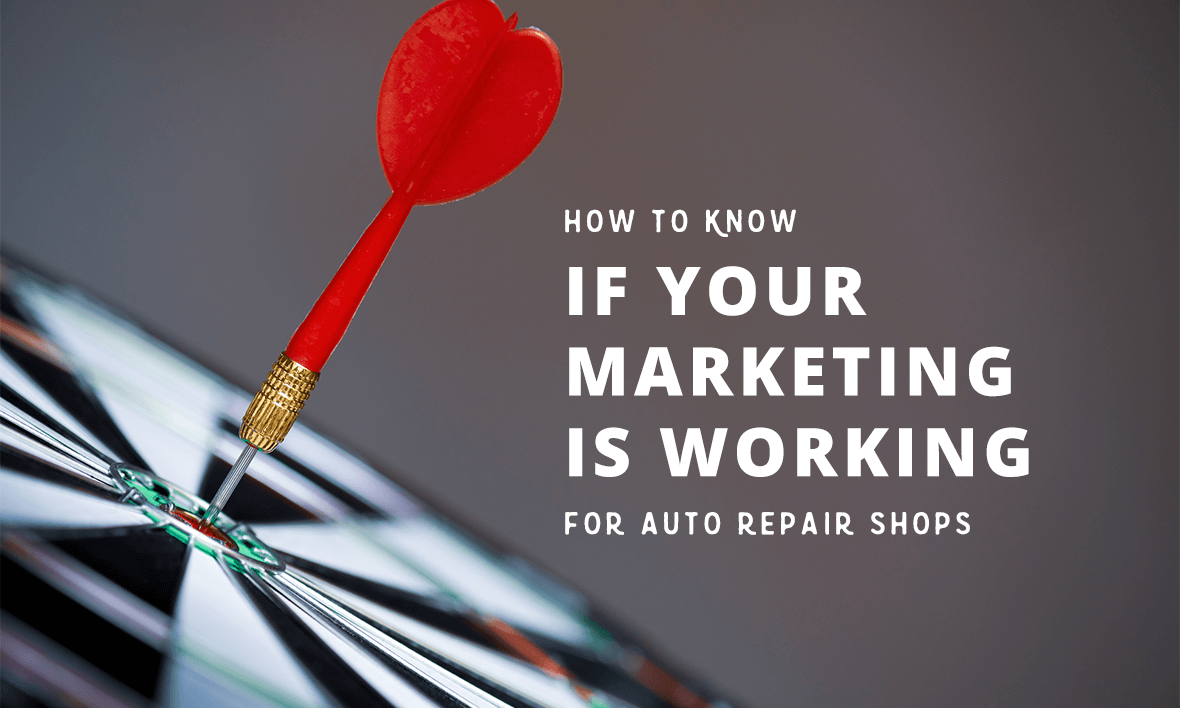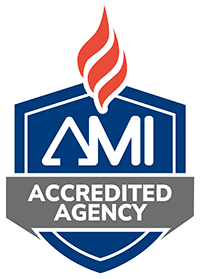You’ve finally made the decision to improve your marketing. You’re one step ahead already!
It’s time to bring in some new customers, bring back existing customers and maybe improve your brand awareness. Auto repair shop marketing could easily focus on one of those areas or all of them depending on what you’re doing.
But is your marketing working?
That’s the biggest question! Not only is it a big question, but it’s also a very important one. No one wants to waste money — ever. I get it, we don’t either. Not only do I not want to waste my own money but I do not want to waste anyone else’s money either.
So, when we take on an auto repair shop as a client, we only do so if we believe we can give them a return on their investment. Let’s look at some of the ways that you can know if your marketing is working.
TRACKING.
It doesn’t matter whether you’re using billboards, social media, newspapers, digital advertising or email marketing — you should be able to track your results.
Given the goal of your marketing there are certainly times where simple brand awareness needs to happen but, for the most part, your overall marketing strategy should include methods that allow you to track your results. For example, some of those methods include using vanity domains, URLs, & phone numbers, call tracking, and URL tracking.
Vanity Domains.
A Vanity Domain is a domain that is different than the primary domain of your website and is used to track a specific campaign or even just a piece of a campaign. These will most commonly be used to track traditional, non-digital marketing.
An example of this would be tracking a billboard.
Let’s say your auto repair shop’s website domain is www.bobsautorepair.com. You could purchase a different domain name to be used on the billboard, such as www.bobsautoservice.com, and then track the traffic through that domain. Since the billboard is the only place it was used, this will give you metrics on the effectiveness of the billboard.
Vanity URLs
A Vanity URL is simply a way of shortening a long URL, adding in relevant words to explain the content of the link and make it trackable.
Using vanity URLs in your auto repair marketing not only helps you take control of the link, but can also provide you with data that will be helpful in determining if that link was clicked, interesting to your audience, and helps promote your brand.
If you’re interested in branding, tracking and optimize your links, one easy vanity URL builder is bit.ly and it’s free! For example, you may want to share this article from Wratchet + Wrench “Developing a Loyalty Program”.
The direct link to the article is https://www.ratchetandwrench.com/articles/7660-developing-a-loyalty-program but with the bit.ly shortening link, it would look like this: http://bit.ly/MattsLoyaltyProgram.
Matt’s Automotive Service Center in Fargo, ND would use this because when he shares that link somewhere he can now track it to see how many people accessed that link. Yes, his email marketing program will track links, Facebook will as well but it never hurts to be an overachiever and track it separately.
Additionally, you can see how, for Matt’s use, that shortened link is branded and looks better to HIS users.
Wratchet + Wrench already has tracking because they own the link – it’s on their webpage and they will still see people that clicked the link because it is on their website. Vanity URLs now allow Matt to track — as well as Wratchet + Wrench! AND… in full transparency, I’m using it in this article to see how many of you clicked the link 🙂

Call Tracking.
We have a client that we’re running a Google AdWords campaign for that complained his ads were not working after just a few short days. He said he wasn’t getting any new business from them.
We’re interested in getting our clients results, not wasting their money, so we started digging into his campaign to see where the problem was.
We use call tracking numbers when we’re running digital ads of any kind. On our end, we could see that he was getting plenty of phone calls, so it didn’t make sense that he wouldn’t be getting new business. The call tracking platform we use allows us to record the calls, and we do. As we listened in on the calls, we figured out what was happening. They weren’t answering the phone! On top of that, their answering machine was the old-school machine that sits on your desk, and the recording was the default robotic message that simply said “We are unable to take your call. Please leave a message”.
He was receiving leads but his sales process was losing them. The end result, we set him up with a company that does professional voicemail and on-hold messaging – and they promised us to do a better job of answering the phone.
That was years ago, and he’s still a client. His Google AdWords and SEO produce A LOT of new clients for him. He refers business to us and routinely tells us that he appreciates us. Let’s just say, he’s a very happy customer!
Call tracking is great if you are running any type of ads including digital via Facebook or even a magazine ad. If you’d like to try call tracking — one program you can use is CallRail. Let us know if you have questions about call tracking. We want your marketing to drive results. Period.
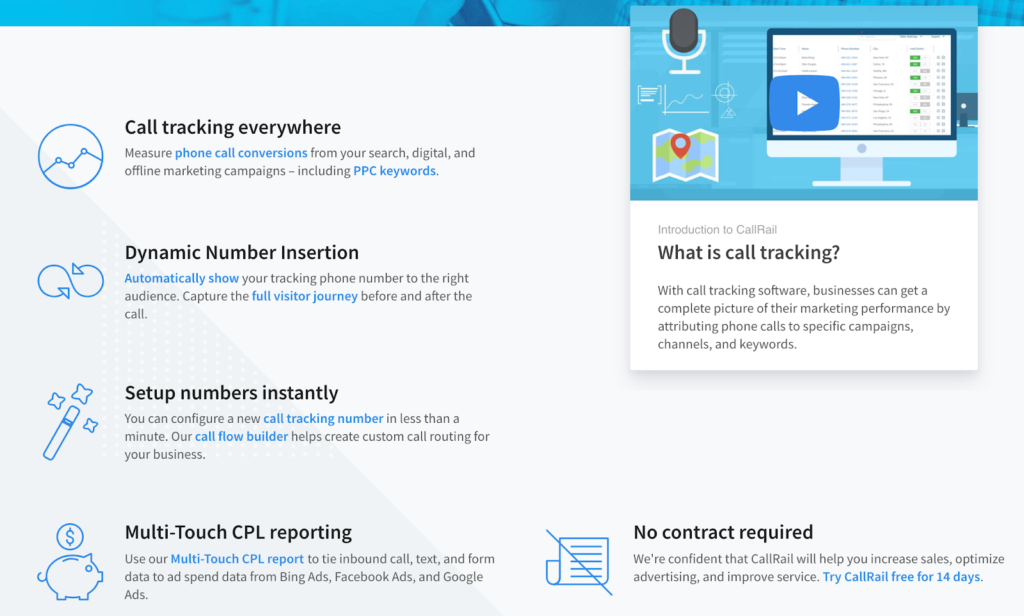
UTM Tracking
Just one of my favorites!
You see these ALL 👏THE 👏TIME👏, too but probably just don’t realize it.
Here’s an example to drive home the point and purpose of using the Google URL Builder. We have created a content piece on the Shop Marketing Pros website called “The Ultimate Guide to Auto Repair Shop Marketing”. It’s a long, highly valuable (very proud to say incredible) piece of content with a lot of marketing tips and information in it.
A great tool for any auto repair shop owner.
I am going to run a Google (or Facebook, or email — you fill in the blank for how you’re going to use your own content/link) Ad campaign driving traffic to this link. The natural link looks like this https://shopmarketingpros.com/guide-auto-repair-shop-marketing, but using the Google URL builder I will go in and add tracking metrics to the link.
Now, inside of my Google Analytics, I can learn where it was clicked from and which campaign source worked.
I can build the unique URLs for the Facebook Ad I’m running, the Google Ad, and the email campaign. I can build links for any of those, and more. Even though all of the different sources are driving traffic to the same place; with UTM data I can measure the effectiveness of each individually.
By using the Google URL Builder you’ll now see the results in your Google Analytics dashboard (more about that further down the blog).
Using my Ultimate Guide to Auto Repair Shop Marketing example in the Google Ad I built the URL out and now it looks like this https://shopmarketingpros.com/guide-auto-repair-shop-marketing?utm_source=Google&utm_medium=cpc&utm_campaign=UltimateGuide&utm_term=auto%20repair%20shop%20marketing&utm_content=storybrandtext.
That’s a crazy long link, I know! Like I said earlier, you see these ALL 👏THE 👏TIME👏 if you look for them.
If you haven’t seen them, start paying attention to links you click on. They’re there! Now, study how they’re using the Google URL Builder. So, in the example above you can see the following:
- My Source = Google
- My Medium = CPC (or cost per click – that’s the type of ad I will run)
- My Campaign = the Ultimate Guide
- My Term = or the keywords I’ll be using will be Auto Repair Shop Marketing
- My Content = storybrandtext . This doesn’t have to be used but we will be A/B testing ads to compare how one ad does against another so the ‘content’ will differentiate our ads for us. So for this one guide, we’ll have two ads running. One ad will use traditional ad text while one ad will use the StoryBrand framework. We want to compare the two ads against one another to see which one drives the most results.
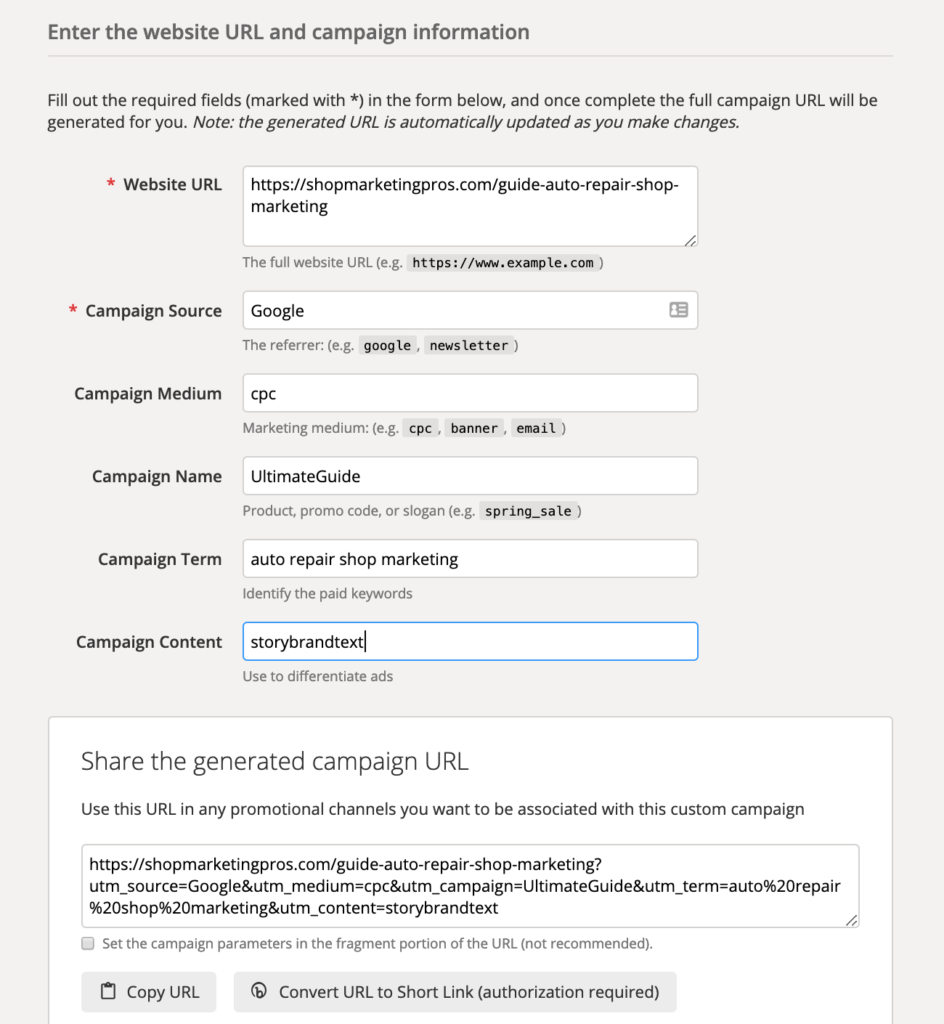
MEASURING.
Let’s move onto actually measuring now. We’ve already talked about using call tracking and tracking URLs but now it is time to put that data to work.
Those tactics mean nothing if you don’t use them.
It’s one thing to be upset that you don’t know if your marketing dollars work, but it’s an entirely different problem if you are actually tracking them but not using that data. I know you can “feel” like you’re busier or perceive that the phone is ringing more, but let’s get down to the cold hard stats and facts.
With tracking and measurement, you can actually compare your auto repair shop marketing to the previous week, month, or year. Maybe you run the same April Car Care Month special promotion each year. With these tactics, you can see how this year’s campaign did against last year. Maybe you do something every year for Teacher Appreciation Week or Valentine’s Day. How do you know which one performed better? By measuring.
You’ll want to dig into the actual number of leads you got, how many calls you received, the number of clicks your links got, how many people filled out the form on your website, how many emails you received, and especially how many people actually scheduled an appointment.
These will depend entirely on the campaign you put together. You may not measure all of those. Maybe the only thing you did was go on the radio and give out your tracking phone number. Maybe all you did was send out an email campaign. The issue here is to not rush through your marketing. Take a moment to stop and think it through. Consider what you want to measure and be sure that you’ve got tracking installed so that you can measure!
Tracking comes first for a reason. You must put the tracking tactic in place (as we discussed above) in order to be able to measure the data.
As Peter Drucker is so well known for saying, “You can’t manage what you don’t measure.” Set yourself up for success. Manage your marketing! Measure your marketing!
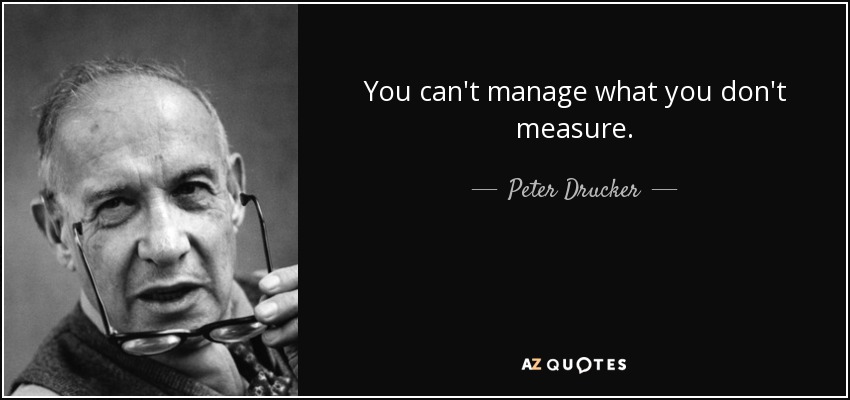
ANALYZING.
Let’s keep going! Are you overwhelmed? I understand. It’s a lot to process but this is what real marketers do. They track, measure and they analyze.
It’s critical.
Merrian-Webster defines the word analyze as a study. To determine the relationship between the parts. So how do we relate that to your marketing? What it really boils down to is time. Taking the time to study your marketing, tracking, and measuring.
The analysis is where you pull those pieces together and you look at your Google Analytics (the free tool connected to your website with enormous amounts of highly valuable data), your call tracking, etc to determine what is working and what is not. You’ll realize what you can make adjustments to, what to turn off completely, and even discover new things you can use in your marketing.
Use this time of analysis to discover what your audience is interested in, what are they engaged with, what are they clicking on, how are they using your website, social media and email marketing. Get to know your customer. It’s a time of discovery. Real analysis is studying the RELATIONSHIP between the PARTS.
When your Google or Facebook ad for auto repair marketing drives that person to click and come to your website — what are they doing after they read that blog or page?
Your website might be GORGEOUS but does it WORK?
- Is it simple, clean and easy to read and navigate?
- Do they come to your site and hang out, get to know you and convert into being a customer?
- OR do they come to your site and immediately leave?
- What are they doing?
Yes, we care about your website looking great and being appealing, but what we really care about is did they call you? Did they click to make an appointment? Did they fill out your contact form?
We were shop owners, please don’t forget that. We understand you need more of the right cars and you need to make every single car matter.
Car Count is more than just counting cars but it is making sure that every car counts.
Every person that clicks your ad counts. Every mom who needs to get her sweet, precious cutie patootie little Brittany or Payton to school counts. Every single person counts. It’s not about the car, it’s the person with things to do, people to see, places to be. Analyze that. When that mom comes to your website are they seeing everything about you or are they seeing a solution to their problem?
THAT is where the magic happens.
Analyze their behavior and you find results. Maybe the first few times you get into these stats you find yourself overwhelmed and confused. Stick with it. Hang in there. It is worth it!
This is where you stop wasting marketing money.
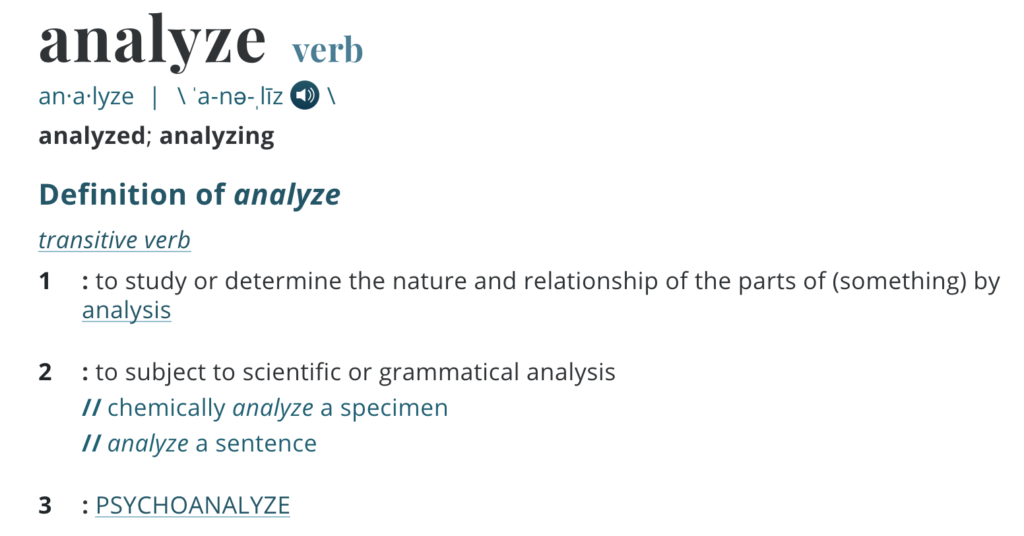
LISTENING
We owned a few shops but my original education and experience are in counseling and teaching. My husband will argue that I am not the best listener, you know how that goes. If you’re married you likely say the same about your spouse 🙂
As business owners, one of the best ways to know if your marketing is working… is literally a God-given. It starts with your ears and also includes your heart and soul.
The last piece for me to share with you about how you can know if your marketing is working is to listen. I know that you know it all when it comes to auto repair shops. Well, I know a lot about people and marketing so please hang with me here.
People will tell you more than you want. Right? Haven’t there been times when you thought you’ve heard enough? Some easy ways to listen is without even asking in person or having a face to face conversation. I’m not saying that’s not important; oh, it is.
Let’s start with your reviews. Everyone is all about the mighty review. I am, too. Trust me! The problem is that they want to focus on the positive reviews. I get more questions about how to get rid of the negative reviews than I care to even share. It really kind of disgusts me, to be honest.
The negative reviews tell you A LOT.
The positive reviews make you feel good.
They bring a smile to your face. You share them with your staff (I hope you do, anyway), you share them on your website (good idea for showing ‘authority’) and also you share them on social media. Great, keep doing that! It’s excellent!
What are you doing with the negative reviews? That, by far, is GOLD. Are you seeing themes, common topics occurring? Are multiple people complaining about the person answering the phone? What about timeliness in responding? Are they telling you that they feel disrespected or spoken down to? Is a common theme that their car is not fixed the first time and they have to come back? Well, maybe it is time to take those negative reviews and listen to them.
Quite possibly you need to look into your own processes internally to fix a few things. Maybe you need to implement some customer service training? This is using your marketing to listen and using your marketing to improve. To — Get — Better. Likewise, use the comments on social media to see what people want, need, and how they talk about you. Your customers may even give you a new tagline.
Back when we owned Peak Automotive in Apex, NC — well before the professional push for female-friendly shops was a big thing — we got our tagline/slogan because we listened to our customers. We would always ask them “how did you hear about us” and time and time again we would hear, “my mom said you’re great with women” or, “my co-worker’s sister said she loves y’all” or “I heard you respect women”. Literally, all the time. Then one day one lady said this “I heard you’re the most female-friendly shop in the Triangle” (the Triangle is referred to for Raleigh, Durham & Chapel Hill in North Carolina).
We took that and started implementing it into our marketing as the tagline “The Triangle’s Most Female Friendly Shop”. #Winning That is what happened. We used what people said about us because we listened and it created a very powerful marketing message for us. It not only directed the words we used but also where we put those words and how we implemented them.
Lastly, another way you can listen to is to set up Google Alerts. It’s a free tool that will allow Google to continually search for the words or phrases you enter and alert you when something new hits the internet. It just monitors the web for new content – the content you want. You can set up a Google Alert for your name, your business name, etc and see when you’re mentioned in an article, etc. It’s not 100% but it will alert you when otherwise you might not know.
As you can see in the screenshot I’m monitoring for our company name. You can do the same!
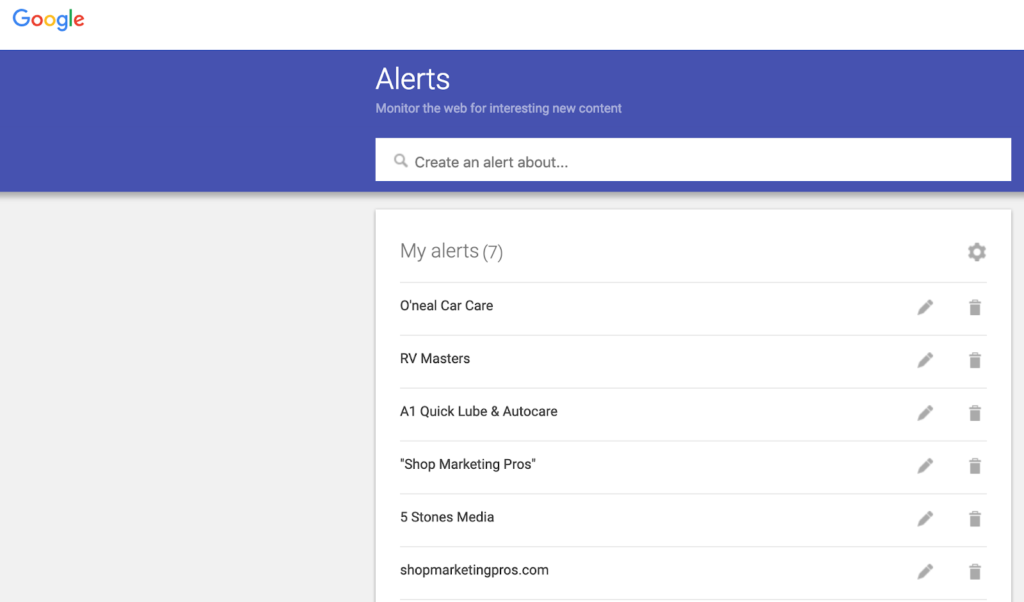
Marketing an auto repair shop is so much more than just putting a message out there, creating a Facebook post or sending an email.
You’ve got to set yourself up for success.
It’s about thinking before you do your marketing, tracking it, measuring it while it’s happening, and then analyzing and listening. You must be paying attention before, during, and after. Taking steps to make adjustments, tweak, and monitor.
Yes, it takes time but this is time well spent. Once you dig in and get the hang of it then it will come easier. I Promise!
If you’re serious about becoming an expert at marketing your shop, check out our Ultimate Guide to Auto Repair Shop Marketing.
Of course, if you get in and determine that you don’t have the time for this, or maybe you have the time but it’s just now how you want to spend your time, then you’ve got a marketing friend in Shop Marketing Pros. We take the burden off of you. Our marketing is done with your results in mind. Contact us today to schedule a consultation and get your auto repair shop marketing to work for you.

About The Author
Kim Walker
In addition to being co-owner of Shop Marketing Pros, Kim is a Master Certified Solution Provider with Constant Contact and a StoryBrand Certified Guide. Kim is a past shop owner and has served as President of ASA North Carolina.

